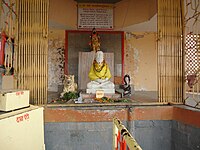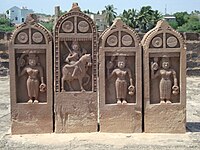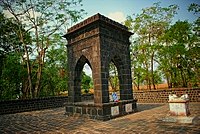Samadhi (shrine)

InHinduism,Sikhism,andSufismasamadhi(samādhi) orsamadhi mandiris a temple, shrine, or memorial commemorating the dead (similar to atombormausoleum),[1][2][3]which may or may not contain the body of the deceased. Samadhi sites are often built in this way to honour people regarded assaints or gurus in Hindu religious traditions,[4]wherein such souls are said to have passed intomahāsamādhi,or were already insamadhi(a state of meditative consciousness) at the time of death.

In Sikhism, the term "samadhi" is used for the mausoleums of eminent figures, both religious and political. Examples include theSamadhi of Ranjit SinghinLahore,and that of MaharajaSher Singhnear Lahore. Hindu equivalents are usually calledchatri,although those forMaratha Empirefigures also often use "samadhi". The forms of structure called "samadhi" vary greatly. The word is sometimes used for a memorialstele,also calledpaliya,a type ofhero stoneonce common in parts ofGujaratandSindh.It may be used for small memorial buildings such as openchatri,often placed around a temple.[citation needed]
The tradition of India iscremationfor most Hindu people at the time of death, while samadhi is generally reserved for very advanced souls, such as yogis and saints,[4]who have already been "purified by the fire of yoga"[5]or who are believed to have been in the state ofsamadhiat the time of death. Samadhi usually involvesinhumationrather than cremation.[4]
Examples[edit]
One of the popular site of pilgrimage in India is the town ofAlandiin the state ofMaharashtrawhere the 13th centuryVarkarisaintDnyaneshwartook Sanjivan Samadhi, or entombed himself in the state of Samadhi. His devotees believe that he is still alive.[6][7]
A. C. Bhaktivedanta Swami Prabhupada(d. 1977) the founder ofISKCON(known as the "Hare Krishna Movement" ), is commemorated with a large Samadhi Mandir in Mayapur,West Bengal.
-
Samadhi ofSri Adi Shankaracharya
-
Samadhi of theMarathaadmiralKanhoji Angre
-
Samadhi with image,Maharashtra
-
Samadhi ofJijabai,the mother of the Maratha emperorChatrapati Shivaji Maharaj,Pachad, Raigadh, Maharashtra
See also[edit]
References[edit]
- ^"Hindi dictionary (Samadhi)".Retrieved18 September2014.
- ^"Oxford Dictionary – American English".Archived fromthe originalon October 22, 2013.Retrieved18 September2014.
- ^"Oxford Dictionary – English".Archived fromthe originalon October 22, 2013.Retrieved18 September2014.
- ^abcMcLaughlin, Mark (July 2021).Flood, Gavin;Frazier, Jessica;Lutjeharms, Rembert (eds.). "Tracing the Roots of Samādhi Burial Practice".Journal of Hindu Studies.14(1).Oxford:Oxford University Presson behalf of theOxford Centre for Hindu Studies:8–26.doi:10.1093/jhs/hiab008.eISSN1756-4263.ISSN1756-4255.OCLC301680132.
- ^Georg Feuerstein,The Encyclopedia of Yoga and Tantra(Boston: Shambhala Publications, 2011), p. 308.
- ^Novetzke 2009,p. 218.
- ^Glushkova 2014,p. 116.
Bibliography[edit]
- Glushkova, Irina (2014),Objects of Worship in South Asian Religions: Forms, Practices and Meanings,Routledge,ISBN978-1317675952
- Dallmayr, Fred (2007),In Search of the Good Life: A Pedogogy for Troubled Times,University Press of Kentucky,ISBN978-0813138589
- Novetzke, Christian Lee (2009),Shared Idioms, Sacred Symbols, and the Articulation of Identities in South Asia,Routledge,ISBN978-1-135-90477-7
External links[edit]
 Media related toSamadhi (shrines)at Wikimedia Commons
Media related toSamadhi (shrines)at Wikimedia Commons- Spiritual Travel – Samadhis of the Sages









